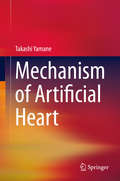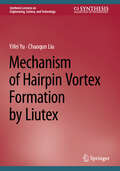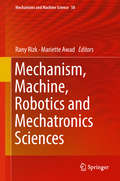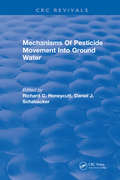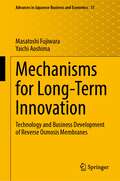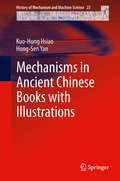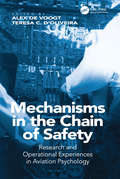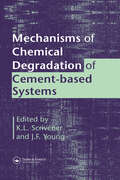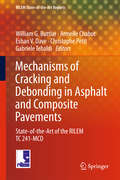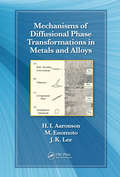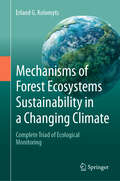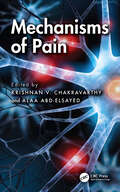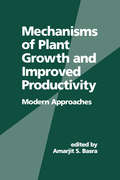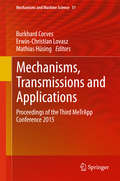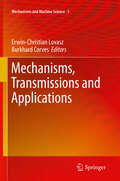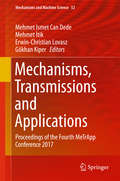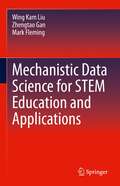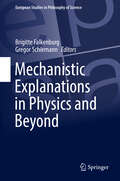- Table View
- List View
Mechanism and Theory in Food Chemistry, Second Edition
by Dominic W.S. WongFor the first time in over twenty-five years, this unique and popular textbook on food chemistry mechanism and theory has received a full update. Emphasizing the underlying chemical reactions and interactions that occur in foods during processing and storage, this book unifies the themes of "what", "how" and "why" in the language of equations, reactions and mechanisms. This book is the only work which provides in-depth focus on aspects of reaction mechanisms and theories in the chemistry of food and food systems. With more than 500 chemical equations and figures, this book provides unusual clarity and relevance, and fills a significant gap in food chemistry literature. It is a definitive source to consult regarding the important mechanisms that make food components and reactions tick.Mechanism and Theory in Food Chemistry has been a popular resource for students and researchers alike since its publication in 1989. This important new edition contains updates on the original text encompassing a quarter century of advances in food chemistry. Many parts of the original chapters are revised to make for smoother navigation through the subjects, to better explain the underlying chemistry concepts and to fulfill the need of adding topics of emerging importance. New sections on fatty acids, lipid oxidation, meat, milk, soybean and wheat proteins, starch and many more have been incorporated throughout the revision. This updated edition provides an excellent source of all the important chemical mechanisms and theories involved with food science.
Mechanism of Artificial Heart
by Takashi YamaneThis book first describes medical devices in relation to regenerative medicine before turning to a more specific topic: artificial heart technologies. Not only the pump mechanisms but also the bearing, motor mechanisms, and materials are described, including expert information. Design methods are described to enhance hemocompatibility: main concerns are reduction of blood cell damage and protein break, as well as prevention of blood clotting. Regulatory science from R&D to clinical trials is also discussed to verify the safety and efficacy of the devices.
Mechanism of Fires: Chemistry and Physical Aspects
by Ali S. Rangwala Vasudevan RaghavanThis textbook on fire dynamics provides a comprehensive description of fuels involved in fires, definitions related to fire, thermodynamics for fire calculations, basics of transport processes and fundamental aspects of combustion related to fire, physical descriptions of premixed and non-premixed flames, detailed analysis of the characteristics of fires from solid and liquid fuels, including ignition, spread and burning rates and physical aspects of fire plumes, compartment fires and dust fires. The contents also highlight fundamental aspects related to the evaporation of liquid fuels and pyrolysis of solid fuels which are explained with simplified mathematical expressions. The book includes pedagogical features such as worked examples to illustrate mathematical calculations involved in fire analysis and end-of-chapter review questions. This book proves useful for students, researchers and industry professionals alike.
Mechanism of Hairpin Vortex Formation by Liutex (Synthesis Lectures on Engineering, Science, and Technology)
by Chaoqun Liu Yifei YuThis book presents the importance of the mechanism of hairpin vortex formation to understanding flow transition, turbulence, and flow control. This book blends direct numerical simulation (DNS) and mathematical analysis with experiments to create a foundation for understanding turbulence. The authors discuss hairpin vortex as a main component of transitional flow and turbulent flow. In addition, Liutex is utilized and described as a theoretical system that presents valid tools for turbulence research. Readers are exposed to understanding 3D and non-linear instability; the Lambda vortex formation; sweeps, ejections, and shear instability; the Kelvin-Helmholtz instability and vortex ring formation; and turbulence generation and sustenance.
Mechanism, Machine, Robotics and Mechatronics Sciences (Mechanisms and Machine Science #58)
by Mariette Awad Rany RizkThis volume contains the Proceedings of the First International Congress for the Advancement of Mechanism, Machine, Robotics and Mechatronics Sciences (ICAMMRMS-2017), held in Beirut, Lebanon, October 2017. The book consists of twenty papers in six different fields covering multiple angles of machine and robotics sciences: mechanical design, control, structural synthesis, vibration study, and manufacturing.This volume is of interest to mechanical as well as electrical engineers.
Mechanism-Based Assessment of Structural and Functional Behavior of Sustainable Cottonid (Werkstofftechnische Berichte │ Reports of Materials Science and Engineering)
by Ronja Victoria ScholzRonja Victoria Scholz assesses the performance of cellulose-based Cottonid for implementation as sustainable construction material. Quasi-static and fatigue tests are performed in varying hygrothermal test conditions using mechanical testing systems in combination with integrable climate chambers. To investigate humidity-driven actuation properties, customized specimen holders are designed. Accompanying microstructural in situ experiments in analytical devices enable a profound understanding of effective material-specific damage and failure mechanisms. The findings are transferred into strength-deformation diagrams as well as Woehler curves, which enable a comparative evaluation of several process-related and environmental influencing factors and can directly be used for dimensioning of Cottonid elements for structural applications. The interpretation of thermoelastic material reponse during loading is used as scientific value for lifetime prediction. Comprehensive investigations on industrial standard materials as well as structurally optimized Cottonid variants provide a scientific basis for categorizing material’s structural and functional performance towards common technical plastics and wood.
Mechanisms Of Pesticide Movement Into Ground Water
by R. HoneycuttThis book is devoted to exploring the mechanism of pesticide movement into groundwater. It describes how pesticides enter ground water/drinking water systems and how regulatory decisions based on these mechanisms will affect the use of pesticides. Experimental results, models, and industry and regulatory perspectives are covered.
Mechanisms and Games for Dynamic Spectrum Allocation
by H. Vincent Poor Tansu Alpcan Holger Boche Michael L. Honig Tansu Alpcan Holger Boche Michael L. HonigPresenting state-of-the-art research into methods of wireless spectrum allocation based on game theory and mechanism design, this innovative and comprehensive book provides a strong foundation for the design of future wireless mechanisms and spectrum markets. Prominent researchers showcase a diverse range of novel insights and approaches to the increasing demand for limited spectrum resources, with a consistent emphasis on theoretical methods, analytical results and practical examples. Covering fundamental underlying principles, licensed spectrum sharing, opportunistic spectrum sharing, and wider technical and economic considerations, this singular book will be of interest to academic and industrial researchers, wireless industry practitioners, and regulators interested in the foundations of cutting-edge spectrum management.
Mechanisms for Generating Mathematical Curves (Springer Tracts in Mechanical Engineering)
by Dan B. Marghitu Iulian Popescu Liliana Luca Mirela CherciuThis book focuses on important mathematical considerations in describing the synthesis of original mechanisms for generating curves. The synthesis is manual and not based on the use of computer tools. Kinematics is applied to confirm the drawing of the curves, and the closed loop method, and in some cases the distances method, is applied in this phase. The book provides all the notions of structure and kinematics that are necessary to calculate the mechanisms and also analyzes other kinematic possibilities of the created mechanisms. Offering a concise, yet self-contained guide to the mathematical fundamentals for mechanisms of curve generation, together with a useful collection of mechanisms exercises, the book is intended for students learning about mechanism kinematics, as well as engineers dealing with mechanism design and analysis. It is based on the authors’ many years of research, which has been published in different books and journals, mainly, but not exclusively, in Romanian.
Mechanisms for Long-Term Innovation: Technology and Business Development of Reverse Osmosis Membranes (Advances in Japanese Business and Economics #31)
by Yaichi Aoshima Masatoshi FujiwaraThis book explores how a long-term innovation can take place based on historical analyses of the development of reverse osmosis (RO) membrane from the early 1950s to the mid-2010s. The RO membrane is a critical material for desalination that is a key to solve water shortages becoming serious in many places of the world. The authors conducted in-depth field studies as well as analyses of rich archival data to demonstrate how researchers, engineers, managers, entrepreneurs, and policymakers interacted each other for this material innovation to be realized. A series of historical analyses in this book uncovered that initial government supports, strategic niche markets, emergence of breakthrough technology, and company-specific rationales played significant roles for companies to overcome four types of uncertainty, technological, market, competition, and social/organizational ones, and enabled the companies to persistently invest in the development and commercialization of the RO membrane. This book depicts that innovation does not arise on a sudden, but that it is actualized through long lasting process with turns and twists, which is driven by many non-economic rationales beyond economic motives.
Mechanisms in Ancient Chinese Books with Illustrations
by Hong-Sen Yan Kuo-Hung HsiaoThis book presents a unique approach for studying mechanisms and machines with drawings that were depicted unclearly in ancient Chinese books. The historical, cultural and technical backgrounds of the mechanisms are explained, and various mechanisms described and illustrated in ancient books are introduced. By utilizing the idea for the conceptual design of modern mechanisms, all feasible designs of ancient mechanisms with uncertain members and joints that meet the technical standards of the subjects' time periods are synthesized systematically. Ancient Chinese crossbows (the original crossbow and repeating crossbows), textile mechanisms (silk-reeling mechanism, spinning mechanisms, and looms), and many other artisan's tool mechanisms are used as illustrated examples. Such an approach provides a logical method for the reconstruction designs of ancient mechanisms with uncertain structures. It also provides an innovative direction for researchers to further identify the original structures of mechanisms and machines with drawings in ancient literature. This book can be used as a textbook and/or supplemental reading material for courses related to history of ancient (Chinese) machinery and creative mechanism design for senior and graduate students.
Mechanisms in the Chain of Safety: Research and Operational Experiences in Aviation Psychology
by Alex De Voogt Teresa D’OliveiraHow should we organize our selection or training procedures? In what way can a flight crew mediate problems? How are we to understand reported errors? Mechanisms in the Chain of Safety presents recent findings in aviation psychology, bringing fresh insights to such questions. Aviation psychologists study personnel selection and training; they evaluate the management of flight operations, and ultimately they analyse the things that went wrong. The strong interrelation between these components allows us to talk about a chain of safety. This volume appraises this chain of safety by considering the mechanisms that determine its effectiveness - input mechanisms, coping mechanisms and control mechanisms. Each contribution discusses a component of the chain while the book as a whole emphasizes and illustrates that understanding the connections between these parts is essential for the future. By addressing these issues the book leads to further considerations such as how mistakes are linked to training and how coping mechanisms should help us to understand errors and accidents. Mechanisms in the Chain of Safety will appeal to aviation professionals (human factors experts, safety managers, pilots, ATCOs, air navigation service providers, etc.) and academics, researchers, graduates and postgraduates in human factors and psychology. Although primarily written for the aviation industry, this book will also be of interest to other high-risk dynamic activities that face similar challenges: the need to present effective and safe outcomes to the public in general and the stakeholders in particular.
Mechanisms of Arsenic Toxicity and Tolerance in Plants
by Masayuki Fujita Mirza Hasanuzzaman Kamrun NaharArsenic is likely the most talked-about metalloid in the modern world because of its toxic effects on both animal and plants. Further, arsenic pollution is now producing negative impacts on food security, especially in many south Asian countries. Since plants are a major food source, their adaptation to As-rich environments is essential, as is being informed about recent findings on multifarious aspects of the mechanisms of arsenic toxicity and tolerance in plants. Although numerous research works and review articles have been published in journals, annual reviews and as book chapters, to date there has been no comprehensive book on this topic.This book contains 19 informative chapters on arsenic chemistry, plant uptake, toxicity and tolerance mechanisms, as well as approaches to mitigation. Readers will be introduced to the latest findings on plant responses to arsenic toxicity, various tolerance mechanisms, and remediation techniques. As such, the book offers a timely and valuable resource for a broad audience, including plant scientists, soil scientists, environmental scientists, agronomists, botanists and molecular biologists.
Mechanisms of Chemical Degradation of Cement-based Systems
by K. L. Scrivener J. F. YoungDeterioration of cement-based materials is a continuing problem, as it results in the substantial shortening of the lives of conventional concrete structures. The main costs result from poor performance and the need for early repair. With more advanced applications, where very long service lives are essential, such as the storage of nuclear waste,
Mechanisms of Cracking and Debonding in Asphalt and Composite Pavements: State-of-the-art Of The Rilem Tc 241-mcd (RILEM State-of-the-Art Reports #28)
by Gabriele Tebaldi William G. Buttlar Armelle Chabot Eshan V. Dave Christophe PetitPremature cracking in asphalt pavements and overlays continues to shorten pavement lifecycles and creates significant economic and environmental burden. In response, RILEM Technical Committee TC 241-MCD on Mechanisms of Cracking and Debonding in Asphalt and Composite Pavements has conducted a State-of-the-Art Review (STAR), as detailed in this comprehensive book. Cutting-edge research performed by RILEM members and their international partners is presented, along with summaries of open research questions and recommendations for future research. This book is organized according to the theme areas of TC 241-MCD - i.e., fracture in the asphalt bulk material, interface debonding behaviour, and advanced measurement systems. This STAR is expected to serve as a long term reference for researchers and practitioners, as it contributes to a deeper fundamental understanding of the mechanisms behind cracking and debonding in asphalt concrete and composite pavement systems.
Mechanisms of Diffusional Phase Transformations in Metals and Alloys
by Hubert I. Aaronson Masato Enomoto Jong K. LeeDeveloped by the late metallurgy professor and master experimentalist Hubert I. Aaronson, this collection of lecture notes details the fundamental principles of phase transformations in metals and alloys upon which steel and other metals industries are based. Mechanisms of Diffusional Phase Transformations in Metals and Alloys is devoted to solid-s
Mechanisms of Forest Ecosystems Sustainability in a Changing Climate: Complete Triad of Ecological Monitoring
by Erland G. KolomytsThe author's working concept of geo-ecological monitoring is presented. For the first time, the full triad of monitoring in its classical definition is considered: "observation (state assessment) – control (prediction) – management (adaptation, feedback, regulation)". The strategic goal of described monitoring research is to reveal the environmental otential of sustainablility of forest ecosystems in the context of modern global warming. The monograph expounds the main statements of author’s topo-ecological predictive concept: “Global Changes on the Local Level”, as a basis of ground bio-ecological and geosystem monitoring of natural ecosystems under global anthropogenic climatic changes. This concept makes it possible to carry out local empirical simulation of the regional bioclimatic trend and thereby reveal the mechanisms of transmission of global and regional climate signals to the local level. On the example of the Volga River basin, predictive empirical-statistical models of the carbon balance of forest ecosytems are presented under conditions of a changing climate. The carbon content in various pools of boreal and nemoral forests were calculated. The global climate models give prognostic estimates of the components of them carbon balance. A quantitative assessment of the ecological resources of forest formations that provide the environment sustainability through mechanisms of regulation of the carbon cycle is given. The adaptation of forest ecosystems to climate change is described through the calculated parameters of their functional sustainability.
Mechanisms of Pain
by Alaa Abd-Elsayed Krishnan V. ChakravarthyPain is a serious health problem. This book presents an intensive review of the anatomy, physiology, and pharmacology of the systems that mediate nociceptive processing. The authors cover areas that include anatomy, central and peripheral nerve processing, tissue and nerve injury states, as well as preclinical and clinical models of pain. Mechanisms of Pain also covers important clinical concepts, with specific emphasis on mechanisms of action. Written by world renowned global faculty, this book covers important areas of science required to understand pain medicine. Important topics covered include post–tissue and nerve injury pain states of primary afferents and the spinal cord. The authors also cover mechanisms of action of clinically relevant analgesics (opiates and non-opiates), psychological aspects of pain, pathophysiology of migraines, as well as the genetics of pain. This comprehensive book is to guide undergraduate, graduate, and clinicians in the field of pain medicine on important concepts related to the science and practice of pain.
Mechanisms of Plant Growth and Improved Productivity Modern Approaches
by Amarjit S. BasraDiscusses the mechanisms of plant productivity and the factors limiting net photosynthesis, describing techniques to isolate, characterize and manipulate specific plant genes in order to enhance productivity. The uptake of carbon and the practical aspects of plant nutrition are discussed.
Mechanisms of Taste Transduction
by Sidney A. Simon Stephen D. RoperMechanisms of Taste Transduction introduces a number of topics essential to a complete understanding of taste. These topics range from the control of food intake to the biophysical mechanisms of transduction and the design of food flavors in the food industry. The responses and organization of special sensory pathways are described in regard to the
Mechanisms, Transmissions and Applications
by Burkhard Corves Erwin-Christian Lovasz Mathias HüsingThis volume deals with topics such as mechanism and machine design, biomechanics and medical engineering, gears, mechanical transmissions, mechatronics, computational and experimental methods, dynamics of mechanisms and machines, micromechanisms and microactuators, and history of mechanisms and transmissions. Following MeTrApp 2011 and 2013, held under the auspices of the IFToMM, these proceedings of the 3rd Conference on Mechanisms, Transmissions and Applications offer a platform for original research presentations for researchers, scientists, industry experts and students in the fields of mechanisms and transmissions with special emphasis on industrial applications in order to stimulate the exchange of new and innovative ideas.
Mechanisms, Transmissions and Applications
by Burkhard J. Corves Erwin-Christian LovaszThe first Workshop on Mechanisms, Transmissions and Applications -- MeTrApp-2011 was organized by the Mechatronics Department at the Mechanical Engineering Faculty, "Politehnica" University of Timisoara, Romania, under the patronage of the IFToMM Technical Committees Linkages and Mechanical Controls and Micromachines. The workshop brought together researchers and students who work in disciplines associated with mechanisms science and offered a great opportunity for scientists from all over the world to present their achievements, exchange innovative ideas and create solid international links, setting the trend for future developments in this important and creative field. The topics treated in this volume are mechanisms and machine design, mechanical transmissions, mechatronic and biomechanic applications, computational and experimental methods, history of mechanism and machine science and teaching methods.
Mechanisms, Transmissions and Applications
by Erwin-Christian Lovasz Mehmet Ismet Can Dede Mehmet İtik Gökhan KiperThe first Workshop on Mechanisms, Transmissions and Applications -- MeTrApp-2011 was organized by the Mechatronics Department at the Mechanical Engineering Faculty, "Politehnica" University of Timisoara, Romania, under the patronage of the IFToMM Technical Committees Linkages and Mechanical Controls and Micromachines. The workshop brought together researchers and students who work in disciplines associated with mechanisms science and offered a great opportunity for scientists from all over the world to present their achievements, exchange innovative ideas and create solid international links, setting the trend for future developments in this important and creative field. The topics treated in this volume are mechanisms and machine design, mechanical transmissions, mechatronic and biomechanic applications, computational and experimental methods, history of mechanism and machine science and teaching methods.
Mechanistic Data Science for STEM Education and Applications
by Wing Kam Liu Zhengtao Gan Mark FlemingThis book introduces Mechanistic Data Science (MDS) as a structured methodology for combining data science tools with mathematical scientific principles (i.e., “mechanistic” principles) to solve intractable problems. Traditional data science methodologies require copious quantities of data to show a reliable pattern, but the amount of required data can be greatly reduced by considering the mathematical science principles. MDS is presented here in six easy-to-follow modules: 1) Multimodal data generation and collection, 2) extraction of mechanistic features, 3) knowledge-driven dimension reduction, 4) reduced order surrogate models, 5) deep learning for regression and classification, and 6) system and design. These data science and mechanistic analysis steps are presented in an intuitive manner that emphasizes practical concepts for solving engineering problems as well as real-life problems. This book is written in a spectral style and is ideal as an entry level textbook for engineering and data science undergraduate and graduate students, practicing scientists and engineers, as well as STEM (Science, Technology, Engineering, Mathematics) high school students and teachers.
Mechanistic Explanations in Physics and Beyond (European Studies in Philosophy of Science #11)
by Brigitte Falkenburg Gregor SchiemannThis volume offers a broad, philosophical discussion on mechanical explanations. Coverage ranges from historical approaches and general questions to physics and higher-level sciences . The contributors also consider the topics of complexity, emergence, and reduction. Mechanistic explanations detail how certain properties of a whole stem from the causal activities of its parts. This kind of explanation is in particular employed in explanatory models of the behavior of complex systems. Often used in biology and neuroscience, mechanistic explanation models have been often overlooked in the philosophy of physics. The authors correct this surprising neglect. They trace these models back to their origins in physics. The papers present a comprehensive historical, methodological, and problem-oriented investigation. The contributors also investigate the conditions for using models of mechanistic explanations in physics. The last papers make the bridge from physics to economics, the theory of complex systems and computer science . This book will appeal to graduate students and researchers with an interest in the philosophy of science, scientific explanation, complex systems, models of explanation in physics higher level sciences, and causal mechanisms in science.

